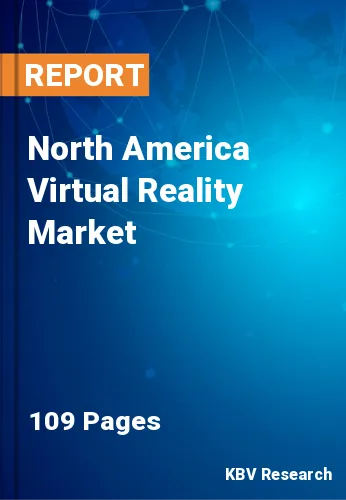The North America Virtual Reality Market would witness market growth of 18.4% CAGR during the forecast period (2020-2026). In addition to vision and sound, organizations are planning to integrate more senses in VR, to enhance the experience of people. The technology of VR is also anticipated to witness high demand in the e-commerce sector. There is a wide-scale adoption of VR in the marketing sector. In order to appeal customers to buy the product, brands are extensively using VR technology. However, VR technology comes with a high cost which is a major restraint for the global virtual reality market in the upcoming years. Also, some VR headsets use wire for connectivity which becomes a barrier in a natural movement. However, leading market players are also developing wireless standalone VR headsets.
Virtual reality creates artificial surroundings with the help of a software program. It is supplied to a person in the way that he suspends belief and perceives it as real. On a computer, virtual reality is generally experienced through 2 out of the 5 senses: sight and sound. The only version of virtual reality is a 3D image that can be explored interactively at PC, generally with the help of manipulating keys or the mouse. More advanced efforts incorporate such strategies as real rooms augmented with wearable computer systems, wrap around display monitors and haptics devices that let you explore the display pictures.
Moreover, there is a massive demand for virtual reality in the retail & e-commerce industry, which further boosts the growth of the market. Also, virtual reality devices are in high demand in healthcare for medical training & patient care management, which will boost the market demand. Furthermore, the growing penetration of head-mount displays in the entertainment and gaming sector is expected to accelerate the virtual reality market growth. The growth of the virtual reality market is also boosted by rapid digitization and accessibility of affordable virtual reality devices. Top tech giants have increasingly been investing and funding in virtual reality solutions which encourage market growth.
Based on Component, the market is segmented into Hardware and Software. Based on Device, the market is segmented into Head-mounted Display (HMD), Gesture-tracking Device (GTD) and Projectors & Display Wall (PDW). Based on Technology, the market is segmented into Semi & Fully Immersive and Non-immersive. Based on End User, the market is segmented into Consumer, Commercial, Healthcare, Enterprise, Aerospace & Defense and Others. Based on countries, the market is segmented into U.S., Mexico, Canada, and Rest of North America.
Free Valuable Insights: Virtual Reality Market in North America is expected to register a CAGR of 18.4% during the forecast period (2020-2026)
The market research report covers the analysis of key stake holders of the market. Key companies profiled in the report include Google, Inc., Microsoft Corporation, Facebook, Inc., Sony Corporation, Samsung Electronics Co., Ltd. (Samsung Group), Autodesk, Inc., Dassault Systemes SE, Vuzix Corporation, Ultraleap Limited (Leap Motion, Inc.) and Eon Reality, Inc.
By Component
By Device
By Technology
By End User
By Country
Companies Profiled
Our team of dedicated experts can provide you with attractive expansion opportunities for your business.

